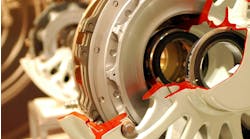Festo VTUX Valve Terminal Offers Multiple Communication Options
The VTUX valve terminal from Festo is a compact and modular unit for pneumatic valve control which is available with multiple communication options to meet varying application needs.
Key features of the VTUX valve terminal include:
- modular design
- high flow rates up to 670 lpm
- centralized or decentralized integration possibilities
- quick and easy installation for applications from 1-128 valves.
Communication Options Provide Design Flexibility
Festo's VTUX valve terminal combines the functions of three of its classic pneumatic valve terminals — the CPV, MPA-L/S and VTUG — with the addition of advanced communication capabilities.
Valve terminals can be ordered with different communication technologies including IO-Link, a multipin connector, or the Festo Automation Platform (AP) for backplane speed communication on industrial fieldbus protocols. This provides designers the flexibility to choose the terminal which best fits for their specific application needs.
The Festo AP communication technology provides the communication and real-time data collection required to meet various safety needs, enable predictive maintenance capabilities and allow for data echange with the cloud for Industrial Internet of Things (IIoT) applications.
This AP technology is available in two forms, CPX-AP-I which is a decentralized option and the centralized version CPX-AP-A. Offering these two options again provides flexibility to designers to integrate the terminal in a manner which best fits their specific application needs. Both versions are equipped with a high degree of protection to IP65/IP67 and are lightweight, compact units for further ease of integration.
Modular Design Allows Valve Terminal Customization
The modular design of the VTUX valve terminals enables further design flexibility for customers, helping them get the right solution for their application requirements. Besides the communication options possible, there are several other ways to customize the terminal to specific pneumatic control system needs.
Each terminal is comprised of manifold sub-bases and valves; the sub-base contains many important aspects for the terminal's operation including the electrical connections, ducts for supplying compressed air and more. Multiple sub-bases can be used in tandem for applications containing anywhere from 1 up to 128 pneumatic valves.
Multiple sub-base options aid customization of the valve terminal to customer needs. For instance, a high-flow rate sub-base is available for applications with higher flow needs. There is also an option for applications requiring the valve terminal to use a smaller footrpint. A terminal can contain both types of sub-bases if required.
Additional features of the VTUX valve terminal include definable pressure zones, various voltage supply options and the lightweight nature of the unit which can benefit its use on a robot arm or other weight-sensitive applications.
READ MORE: Pneumatics Provide a Tried-and-True Technology for Robotics



